In 2008, Subway introduced a tantalizing deal: For just $5, one could purchase any “footlong” (12-inch) sandwich.
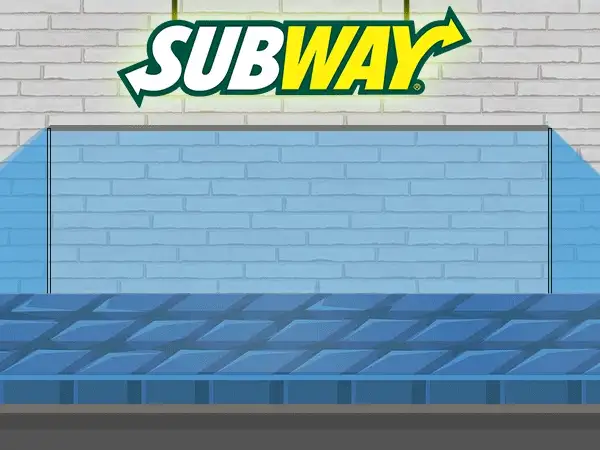
The promotion was a smash hit with cash-strapped customers during the recession — and its jingle (“five-, five-, five-dollar footlong…”) became the company’s calling card.
Within a year, foot traffic skyrocketed across the franchise’s thousands of locations. Revenue from $5 footlongs alone topped $3.8B.
It was, according to many industry analysts, one of the most successful promotions in the history of American cuisine.
But the deal wasn’t so hot for Subway’s franchisees.
Eager to grow at all costs, Subway refused to let the promotion die. As inflation drove up the cost of doing business, the $5 footlong became financially unsustainable for many of the independent entrepreneurs who owned the company’s eateries.
This is the story of a promotion gone very right, and then very wrong. But it’s also a parable about the oft-conflicting goals of small business owners and large corporations.
The father of the $5 footlong
Twenty years earlier, in 1988, an enterprising fellow named Stuart Frankel bought his first Subway franchise in Miami.
A tell-it-like-it-is New Yorker, Frankel had migrated to Florida with his wife in the ‘70s. After stints running a drug store and a video outlet, he decided to try his hand at slinging sandwiches.
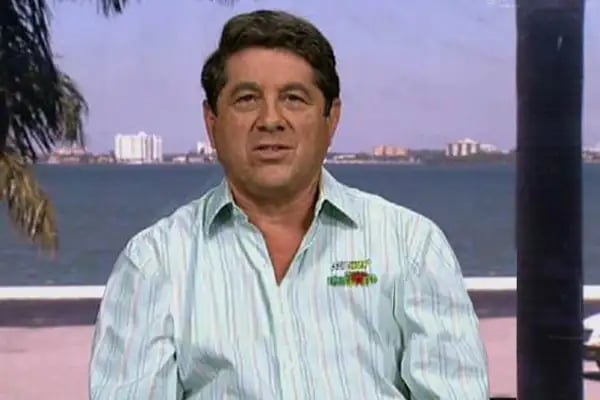
Stuart Frankel in the early 2000s (Screenshot via Fox Business)
At the time, Subway was a relative newcomer to the scene.
Launched in 1965 by 17-year-old Fred DeLuca, Subway settled on a franchising model in 1974, leasing out the right to use its branding to individual shop owners across the US.
By 1988, the business had expanded to 2.2k shops and $360m in annual sales. And like many franchisees, Frankel saw an opportunity to claim a stake in the fast-growing chain.
Over the next decade, he built several Subway shops in South Florida, including two near a bustling hospital.
Business was good, but he felt he needed some kind of differentiator — a gimmick to take things up a notch.
One day in 2003, inspiration struck.
“I sat down with my manager and said we’re going to try something different,” he told The Hustle in a recent interview. “Every Saturday and Sunday, we’re going to sell all our footlongs for $5 each instead of $6.”
He slapped up a few crude signs in the window, not expecting much.
Within the first 2 weeks, Frankel saw his sales jump from $14k to $23k per week — more than 4x what the average Subway shop brought in.
Frankel gradually grew his local empire to 10 Subway shops and implemented his $5 promo at other locations with similar success. Other Subway owners adopted it and saw sales swell by 35% to 50%+.
All the while, Frankel kept scrupulous records of the positive impact the deal had on metrics like foot traffic and revenue, which he passed along to corporate.
Nobody listened.

The Subway where Frankel invented the $5 footlong promotion, at Jackson Memorial Hospital in Miami (Google Maps)
But in 2008, the top brass at Subway started to pay attention.
After witnessing one shop’s sales double in one day after integrating the $5 footlong promo, a Subway development agent named Steve Sager informed Subway’s execs that it might be worth testing on a national level.
Frankel was invited to join the Subway Franchisee Advertising Fund Trust (SFAFT) — a board of franchisees who decide what to do with the chain’s ad dollars — and the $5 footlong was brought up for vote.
In the meeting, the idea courted serious backlash.
“The company was skeptical the $5 footlong could make money,” said Frankel. “To be frank, they thought I was a fucking idiot.”
Eventually, the board reluctantly agreed to a pilot test.
On March 23, 2008, just a few months before the US economy spiraled into a recession, the $5 footlong made its national debut.
$5 footlong mania
The promotion came along at the right time for Subway.
Over the previous decade, Subway’s marketing team had put all its chips on Jared Fogle — a college kid who claimed to have lost 225 pounds by subsisting on a diet of subs. Fogel and his oversized pants had been an inescapable presence in commercials and ads.
But the food business was undergoing a seismic shift toward value.
“Cheap food was all people were eating during the recession,” Jonathan Maze, the editor-in-chief of Restaurant Business, told us. “You had a large percentage of the population trading down to lower-end restaurants.”
McDonald’s had recently seen massive success with its Dollar Menu, and Subway wanted to switch its national advertising focus to affordability.
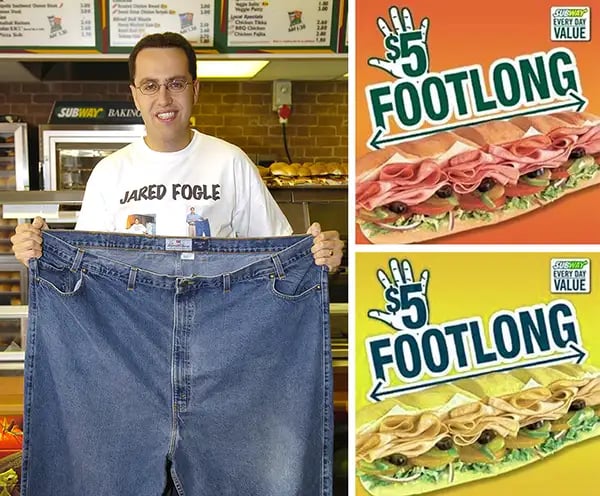
Left: Jared Fogle poses with a pair of his old pants in 2005 (Photo by David Lodge/FilmMagic); Right: Ads for the $5 footlong promo
After initially testing weekends only, Subway rolled out the $5 footlong promo as an everyday price point at locations across the country.
“It pushed Subway to the stratosphere,” Maze said.
In the 2008-09 fiscal year alone, the $5 footlong promo generated $3.8B in sales — more than the entire annual revenue of franchises like Arby’s and Domino’s Pizza.
For most of Subway’s franchisees, the promo was mutually beneficial.
Promotions are typically loss leaders — that is, the promotional item itself is sold at a loss in the hopes that ancillary sales will make up for it. But two things made the $5 footlong financially viable at the time:
- Cheaper labor, food costs, and rent in 2008 meant that franchisees could still make a profit on the reduced price.
- A huge spike in customer volume during this time offset the thinner margins on the sandwiches.
As other restaurants and chains suffered, Subway franchisees saw a 25% average uptick in sales.
“All of a sudden, customers who’d pay $3 for a 6-inch were paying $5 for a footlong,” said Frankel. “Traffic went up, sales went up, profits went up.”

Zachary Crockett / The Hustle
While the $5 footlong promotion was only intended to be temporary, Subway execs began to question whether they should ever phase it out.
As months of boosted metrics continued, Tony Pace, the company’s ex-marketing head, was insistent on running it “as long as it made economic sense.”
“If you had a brand that represented nearly $4B in sales,” he told BusinessWeek in 2009, “would you plan an exit strategy for it?”
The promotion stayed put for several years in various forms.
But in the background of the $5 footlong’s runaway success, bigger problems were brewing at the sandwich giant.
A footlong of discontent
For years, Subway had doubled down on expanding its footprint, encouraging new franchisees — largely recent immigrants enticed by the chain’s relatively low franchise startup cost — to open some 5k new stores.
Touting an “anywhere and everywhere” approach, Subway soon overtook McDonald’s as America’s largest restaurant chain.
Subway restaurants popped up at gas stations, truck stops, and even churches. And Subway’s development agents — the folks tasked with this expansion — often opened up new stores too close to each other, cannibalizing franchisee’s profits.
“If you’ve ever noticed 2 Subways seemingly next door to each other, the reason is because Subway is happy to get 2x the exposure until one goes out of business,” said Kenny Rose, the CEO of the franchise investing firm FranShares.
To understand why this is the case, it’s important to take a quick step back here and explain Subway’s business model.
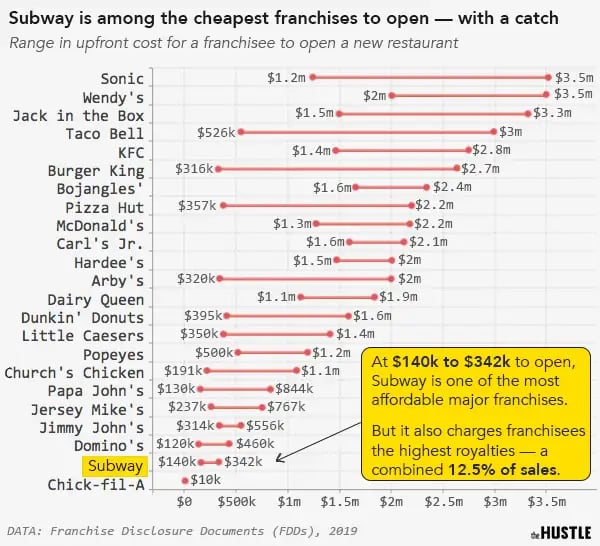
Zachary Crockett / The Hustle
For franchisees, Subway is appealing in that it boasts the lowest relative entry cost of any major franchise: The average total investment to launch one only runs $140k to $342k, compared to $1.3m to $2.2m for a McDonald’s.
In return, Subway makes money from taking an industry-leading 12.5% cut of its franchisees’ weekly gross sales.
Expanding the number of stores at all costs drove up overall gross sales in the short term, but it proved to be detrimental to independent operators. Coupled with the rising costs of rent, labor, and food, the increased local competition made the $5 footlong untenable for many franchisees.
Around 2012, Subway quietly phased out the promotion, and footlong subs returned to a $6 price point.
But the saga didn’t end there
For nearly 5 years, Subway abandoned the $5 footlong campaign. And in the interim, a series of unrelated issues hampered business:
- In 2013, an Australian teenager launched an international uproar when he measured a footlong sandwich at just 11 inches; a class-action false advertising lawsuit ensued, resulting in an eventual $525k settlement and weeks of bad press.
- In 2015, Jared Fogle — the company’s long-time spokesman, was sentenced to 15.5 years in federal prison for possession of child pornography.
- In 2016, the company posted a net decline in locations for the first time in its 40+-year franchising history.
Subway’s overzealous expansion strategy — and increased competition from Jimmy John’s and Jersey Mike’s — led to massive store closures, falling profits, and a 25% decline in foot traffic.
So, the company resurrected its famous promotion.
In 2017, the $5 footlong made an unexpected comeback in the form of a $4.99 deal.
This decision was met with uproar from franchise owners, who claimed the promo made it impossible to make a profit. The unit economics proved their case: Even the cheapest option, the turkey sub, barely broke even.
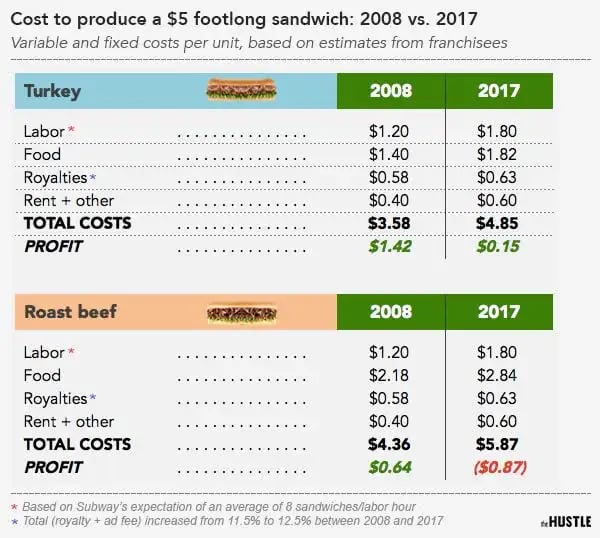
Zachary Crockett / The Hustle
In the face of opposition, Subway discontinued the offer in 2018.
But less than 2 years later, it was back on tap again.
In January of 2020, Subway hired former Burger King CEO John Chidsey, who’d previously led efforts on a $1 double cheeseburger promotion at Burger King.
During a time when many franchisees saw a 40-80% decrease in sales due to COVID-19, the promo was reinvented again — this time, as a $10 deal for 2 footlongs.
Though Subway didn’t force its franchisees to participate, many felt pressured to do so, since the chain’s contract stipulates that an agreement can be terminated for nearly any reason.
“There was — and still is — a lot of retaliation for not stepping in line,” one long-time Subway owner, who asked to remain anonymous, told The Hustle. “You’re allowed to do what you want, but there are consequences if they think you’re hurting the brand.”
Nonetheless, some franchisees revolted, filing a complaint with the FTC that they were being “bullied into honoring a promotion that is unprofitable.”
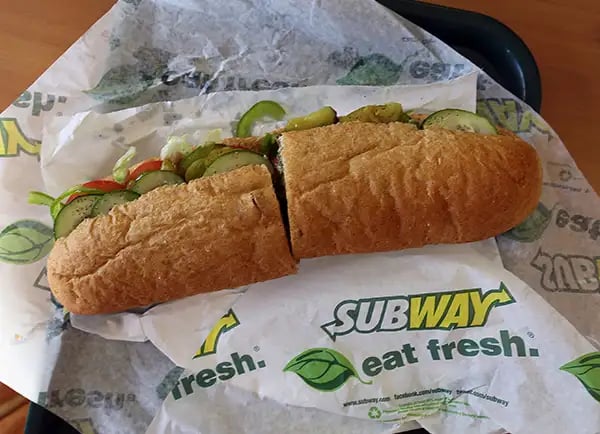
A footlong sub at a Subway franchise in Miami, Florida (Photo by Joe Raedle/Getty Images)
Just 2 weeks into the planned 11-week promotion, the $5 footlong was laid to rest for a third time.
For Subway, it was the cap to a terrible year: In 2020, the ailing franchise closed an estimated 10% of its 22k units, drawing questions about the long-term future of its operations.
Since 2012, Subway owners have seen their average annual sales dip from $482k to $417k per store — a significant decline in what is already a slim-margin business.
Will the $5 footlong return again?
Subway didn’t respond to The Hustle’s requests to comment on this story. But Maze, of Restaurant Business, seems to be bullish on the prospect.
“That thing is never going to die,” he said. “It’s going to come back in some different form, at some point in time.”
Frankel has a different take.
“There’s no way in hell they bring it back,” he said. “It’s done.”
The father of the $5 footlong, now 70, says the only recognition he ever got from the sandwich chain for his $3.8B innovation was a plaque from corporate thanking him for his service.
He’s since sold all but one of his Subway shops — and he’s long since abandoned the idea that made him famous in franchisee circles.
“I haven’t accepted a $5 footlong coupon in 6 years,” he said. “We have a sign in the window telling people we don’t do it anymore.”
